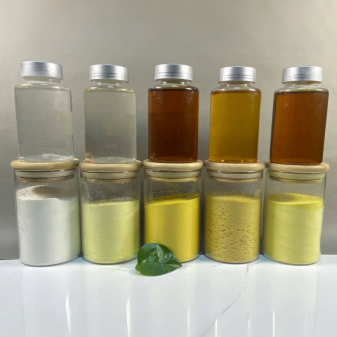Polymerized aluminum chloride (PAC) is a widely used inorganic flocculant, but it exists in a large amount, if the
polyacrylamide and polymerized aluminum chloride synergistic effect, will greatly reduce the amount of PAC dosage. And can achieve good treatment effect, low cost and other characteristics. Printing and dyeing or dyestuff wastewater after biochemical treatment of chromaticity is often difficult to meet the standard, the use of polymerized aluminum chloride for deep decolorization treatment effect is better.
Printing and dyeing wastewater flocculation decolorization mechanism is based on adsorption bridging theory. In terms of inorganic flocculants, iron, aluminum and other flocculants undergo hydrolysis and polymerization reactions, generating high-valent polyhydroxyl cations, and colloids in the water for the compression of the double layer, electric neutralization and destabilization, adsorption and bridging and supplemented with precipitate net trapping, sweeping effect, precipitation to remove the generation of coarse flocs (alumina), so as to achieve the purpose of decolorization of water purification. For organic polymer flocculants, in addition to electrical neutralization and bridging effect, there may also be similar chemical reaction bonding flocculation mechanism.
Biological treatment of dyeing wastewater color removal is generally only 50% to 60%; and physicochemical methods of coagulation and precipitation decolorization up to 50% to 90%, generally for direct dyes, reducing dyes, sulfur dyes, disperse dyes and colloidal substances have a better removal effect, the color removal rate of up to 80% to 90%, the COD removal rate of up to 50% to 80%, but for acidic dyes, reactive dyes, But for acid dyestuff, reactive dyestuff, metal complex dyestuff and cationic dyestuff, the decolorization effect is not good, generally only 50%~60%.
At present, polymerized aluminum chloride (PAC) is generally used as coagulant. Polymerized aluminum chloride has good decolorization effect on dye wastewater, and it has good decolorization effect on 5 types of dyestuffs when its dosage is 0.05%. Polymerized aluminum chloride is suspended in the wastewater of paint, reducing dyes decolorization efficiency is good, on the sulfide dyes, naftal dyes, followed by water-soluble reactive dyes decolorization effect is poor. In addition to increase the dosage of polymerized aluminum chloride, can improve the decolorization effect. For example, for printing and dyeing wastewater containing sulfide dyes and naftal dyes, when the dosage of polymerized aluminum chloride is increased to 0.08% and 0.1%, its decoloration efficiency will be increased to 81% and 90% accordingly, but the treatment cost is also increased accordingly.

The main products of flocculant manufacturer Xinhuan Water Treatment are:
White polyaluminium chloride (food grade),
drinking grade polyaluminium chloride,
industrial grade polyaluminium chloride,
anionic polyacrylamide,
cationic polyacrylamide,
nonionic polyacrylamide, petroleum recycling polyacrylamide, oil recovery polyacrylamide, polyacrylamide, polymer flocculant polymer flocculation coagulant, polymeric ferrous sulphate, polymerized iron and aluminium chloride, and other water treatment chemicals. Welcome customers to write to us to negotiate business! Tel/WhatsApp:86 15936201203 Email:maggie@xhwtm.com Contact:Maggie
 The main products of flocculant manufacturer Xinhuan Water Treatment are:
White polyaluminium chloride (food grade), drinking grade polyaluminium chloride, industrial grade polyaluminium chloride, anionic polyacrylamide, cationic polyacrylamide, nonionic polyacrylamide, petroleum recycling polyacrylamide, oil recovery polyacrylamide, polyacrylamide, polymer flocculant polymer flocculation coagulant, polymeric ferrous sulphate, polymerized iron and aluminium chloride, and other water treatment chemicals. Welcome customers to write to us to negotiate business! Tel/WhatsApp:86 15936201203 Email:maggie@xhwtm.com Contact:Maggie
The main products of flocculant manufacturer Xinhuan Water Treatment are:
White polyaluminium chloride (food grade), drinking grade polyaluminium chloride, industrial grade polyaluminium chloride, anionic polyacrylamide, cationic polyacrylamide, nonionic polyacrylamide, petroleum recycling polyacrylamide, oil recovery polyacrylamide, polyacrylamide, polymer flocculant polymer flocculation coagulant, polymeric ferrous sulphate, polymerized iron and aluminium chloride, and other water treatment chemicals. Welcome customers to write to us to negotiate business! Tel/WhatsApp:86 15936201203 Email:maggie@xhwtm.com Contact:Maggie